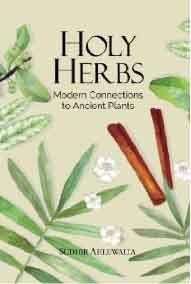- Home
- Archive -Dec 2017
- An ode to natur. . .

An ode to nature
- In :
- Personal Growth
Holy Herbs
Modern Connections to Ancient Plants
by Sudhir Ahluwalia
Fingerprint Life (Prakash Books India Pvt Ltd),
Rs 399; pages 303
Did you know that the humble Pudin Hara tablets found in most of our Indian households, seem to trace their history way back to ancient Egypt, Greece and China? Apparently, Chinese medical writings, c. 659 AD, mention mint as a treatment for stomach aches; the herb is still used to get relief from indigestion, common colds and bad breath. Author Sudhir Ahluwalia digs into history records of ancient civilisations to unearth various similar facts about the relevance of plants and herbs, which he adroitly presents in his latest book, Holy Herbs.
Holy Herbs is an intriguing attempt at collating interesting information about plants and herbs which formed a link between the ancient civilisations of the East and the West. The book is packed with flavourful facts (Greeks break a pomegranate on the ground to initiate weddings and other celebrations) and generous slices from history (“The black seed is healing for every disease except death.”—Prophet Muhammad is believed to have said about black cumin in the hadith, Sahih al Bukhari).
The idea behind this book, in the writer’s words, is to evaluate the relevance of herbs and plants in modern medicine, by tracing their significance in ancient civilisations. Sudhir successfully lists the reasons which made these civilisations attribute sacredness to certain plants and herbs, yet again cementing the fact that our ancestors were way ahead than modern sciences, in acknowledging nature’s role in human survival. The book states how Sushruta Samhita, the renowned ancient Indian medicine treatise, recorded around 770 medicinal plants. It also mentions their origin and botanical identity, describes their value and use, and gives an overview on the current state of research on herbal products.
Holy Herbs is structured as an encyclopedia of prominent herbs and plants that find mention in sacred texts like the Bible, the Quran, the Talmud, and the Hadiths, underscoring the archaeological evidence that supports their erstwhile use as curative plants. The book promises to be an engaging read for alternative medicine scholars, naturopaths, herbal product users and members of organic and green living communities. It also stirs fascination in people like me who are constantly trying to align with natural ways of eating and healing.
-Punya Srivastava
To read more such articles on personal growth, inspirations and positivity, subscribe to our digital magazine at subscribe here
Life Positive follows a stringent review publishing mechanism. Every review received undergoes -
- 1. A mobile number and email ID verification check
- 2. Analysis by our seeker happiness team to double check for authenticity
- 3. Cross-checking, if required, by speaking to the seeker posting the review
Only after we're satisfied about the authenticity of a review is it allowed to go live on our website
Our award winning customer care team is available from 9 a.m to 9 p.m everyday
The Life Positive seal of trust implies:-
-
Standards guarantee:
All our healers and therapists undergo training and/or certification from authorized bodies before becoming professionals. They have a minimum professional experience of one year
-
Genuineness guarantee:
All our healers and therapists are genuinely passionate about doing service. They do their very best to help seekers (patients) live better lives.
-
Payment security:
All payments made to our healers are secure up to the point wherein if any session is paid for, it will be honoured dutifully and delivered promptly
-
Anonymity guarantee:
Every seekers (patients) details will always remain 100% confidential and will never be disclosed
